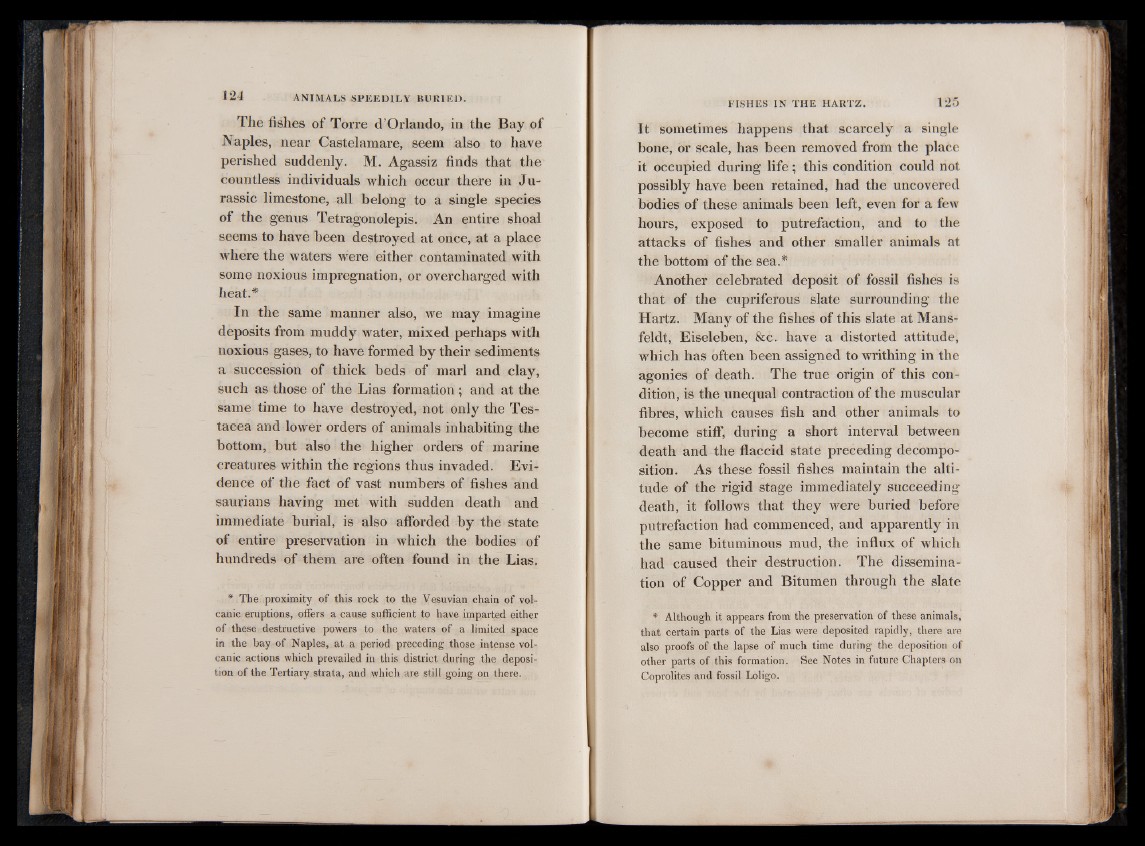
The fishes of Torre d’Orlando, in the Bay of
Naples, near Castelamare, seem also to have
perished suddenly. M. Agassiz finds that the
countless individuals which occur there in Jurassic
limestone, all belong to a single species
of the genus Tetragonolepis. An entire shoal
seems to have been destroyed at once, at a place
where the waters were either contaminated with
some noxious impregnation, or overcharged with
heat.*
In the same manner also, we may imagine
deposits from muddy water, mixed perhaps with
noxious gases, to have formed by their sediments
a succession of thick beds of marl and clay,
such as those of the Lias formation; and at the
same time to have destroyed, not only the Tes-
tacea and lower orders of animals inhabiting the
bottom, but also the higher orders of marine
creatures within the regions thus invaded. Evidence
of the fact of vast numbers of fishes and
saurians having met with sudden death and
immediate burial, is also afforded by the state
of entire preservation in which the bodies of
hundreds of them are often found in the Lias.
* The proximity of this rock to the Vesuvian chain of volcanic
eruptions, offers a cause sufficient to have imparted either
of these destructive powers to the waters of a limited space
in the bay of Naples, at a period preceding those intense volcanic
actions which prevailed in this district during the deposition
of the Tertiary.strata, and which are still going on there.
It sometimes happens that scarcely a single
bone, or scale, has been removed from the place
it occupied during life ; this condition could not
possibly have been retained, had the uncovered
bodies of these animals been left, even for a few
hours, exposed to putrefaction, and to the
attacks of fishes and other smaller animals at
the bottom of the sea.*
Another celebrated deposit of fossil fishes is
that of the cupriferous slate surrounding the
Hartz. Many of the fishes of this slate at Mans-
feldt, Eiseleben, &c. have a distorted attitude,
which has often been assigned to writhing in the
agonies of death. The true origin of this condition,
is the unequal contraction of the muscular
fibres, which causes fish and other animals to
become stiff, during a short interval between
death and the flaccid state preceding decomposition.
As these fossil fishes maintain the altitude
of the rigid stage immediately succeeding
death, it follows that they were buried before
putrefaction had commenced, and apparently in
the same bituminous mud, the influx of which
had caused their destruction. The dissemination
of Copper and Bitumen through the slate
* Although it appears from the preservation of these animals,
that certain parts of the Lias were deposited rapidly, there are
also proofs of the lapse of much time during the deposition of
other parts of this formation. See Notes in future Chapters on
Coprolites and fossil Loligo.